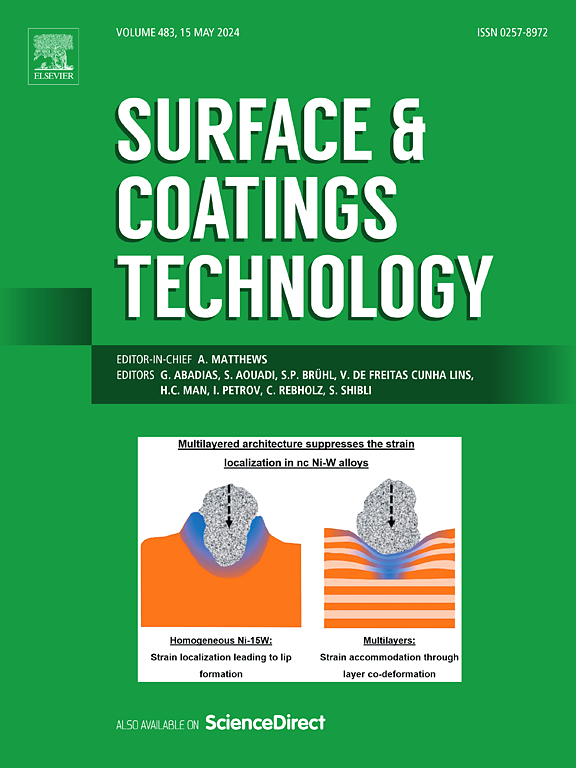Inconel 718大空腔冷修补喷雾引起的残余应力——试样几何形状的影响
IF 5.3
2区 材料科学
Q1 MATERIALS SCIENCE, COATINGS & FILMS
引用次数: 0
摘要
根据之前关于冷气喷涂(CGS)用于修复平面Inconel 718部件大空腔的适用性的研究,制作了圆形试样几何形状,其中包含深度为4mm的锥形空腔。采用热、冷两组工艺参数,用CGS填充相似材料的空腔。为了评估喷涂状态下的局部残余应力状态,在lae - langevin研究所(ILL)的SALSA仪器上进行了无损高分辨率中子衍射实验。残余应力分布的二维映射在试样中心的横截面积上确定。此外,还进行了补充的实验室残余应力分析。残余应力分析结果表明,修复区域内的残余压应力与修复区域附近基体上的残余拉应力相平衡。补充金相研究表明,修复填料与基体之间有良好的结合,修复区域内有强烈变形的颗粒。后者表明在CGS过程中发生了明显的加工硬化。中子衍射分析和显微硬度分布记录的衍射线宽度的增加进一步支持了这一点。本文章由计算机程序翻译,如有差异,请以英文原文为准。

Residual stresses induced by Inconel 718 cold gas repair spray of large cavities — On the influence of the sample geometry
Following previous studies regarding the suitability of cold gas spray (CGS) for repairing large cavities in flat Inconel 718 components, circular specimen geometries were produced which contained tapered cavities with a depth of 4 mm. Two sets of process parameters, a hot and a cold parameter set, were used to fill the cavities with similar material by employing CGS. To evaluate the local residual stress state in the as-sprayed condition, non-destructive high-resolution neutron diffraction experiments were performed on the SALSA instrument at the Institut Laue-Langevin (ILL). 2D mappings of residual stress distributions were determined over the cross-sectional area in the centre of the specimens. Additionally, complementary laboratory residual stress analyses were carried out. The results of residual stress analyses indicate compressive residual stresses within the repaired zone, which are balanced by tensile residual stresses in the substrate adjacent to the repair site. Supplementary metallographic investigations show a good bonding between the repair filling and the substrate as well as strongly deformed particles within the repaired region. The latter indicates significant work hardening occurring during CGS. This is further supported by the increased widths of the diffraction lines recorded by neutron diffraction analyses and micro hardness distributions.
求助全文
通过发布文献求助,成功后即可免费获取论文全文。
去求助
来源期刊

Surface & Coatings Technology
工程技术-材料科学:膜
CiteScore
10.00
自引率
11.10%
发文量
921
审稿时长
19 days
期刊介绍:
Surface and Coatings Technology is an international archival journal publishing scientific papers on significant developments in surface and interface engineering to modify and improve the surface properties of materials for protection in demanding contact conditions or aggressive environments, or for enhanced functional performance. Contributions range from original scientific articles concerned with fundamental and applied aspects of research or direct applications of metallic, inorganic, organic and composite coatings, to invited reviews of current technology in specific areas. Papers submitted to this journal are expected to be in line with the following aspects in processes, and properties/performance:
A. Processes: Physical and chemical vapour deposition techniques, thermal and plasma spraying, surface modification by directed energy techniques such as ion, electron and laser beams, thermo-chemical treatment, wet chemical and electrochemical processes such as plating, sol-gel coating, anodization, plasma electrolytic oxidation, etc., but excluding painting.
B. Properties/performance: friction performance, wear resistance (e.g., abrasion, erosion, fretting, etc), corrosion and oxidation resistance, thermal protection, diffusion resistance, hydrophilicity/hydrophobicity, and properties relevant to smart materials behaviour and enhanced multifunctional performance for environmental, energy and medical applications, but excluding device aspects.
 求助内容:
求助内容: 应助结果提醒方式:
应助结果提醒方式:


